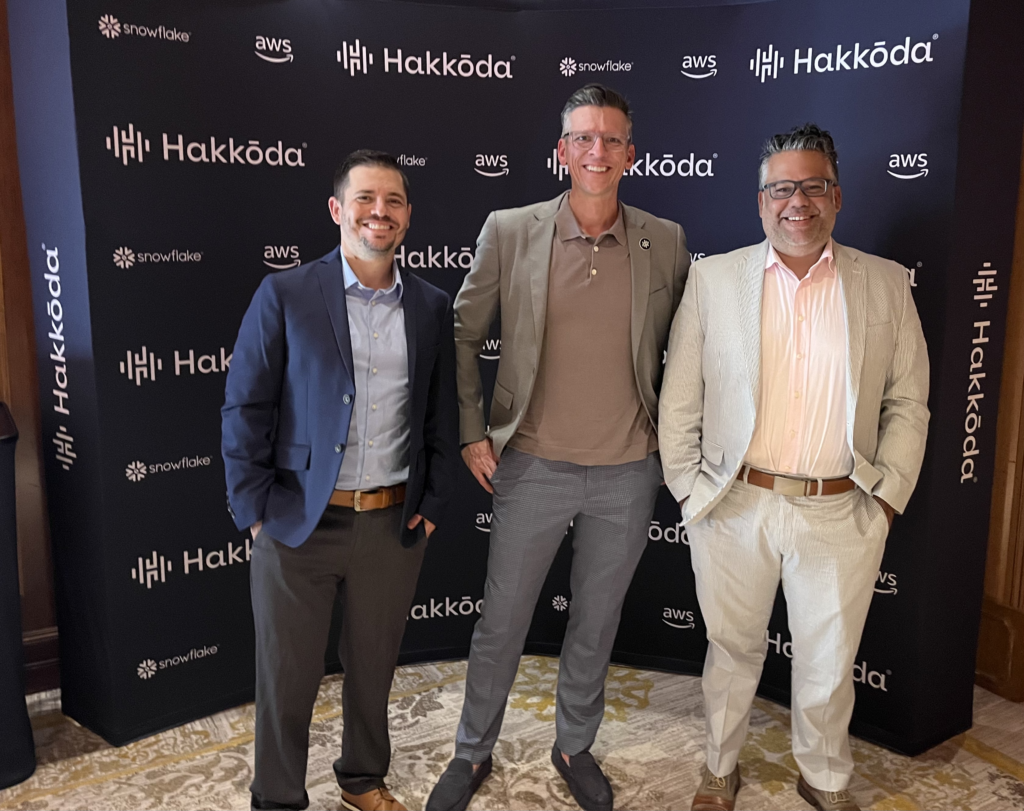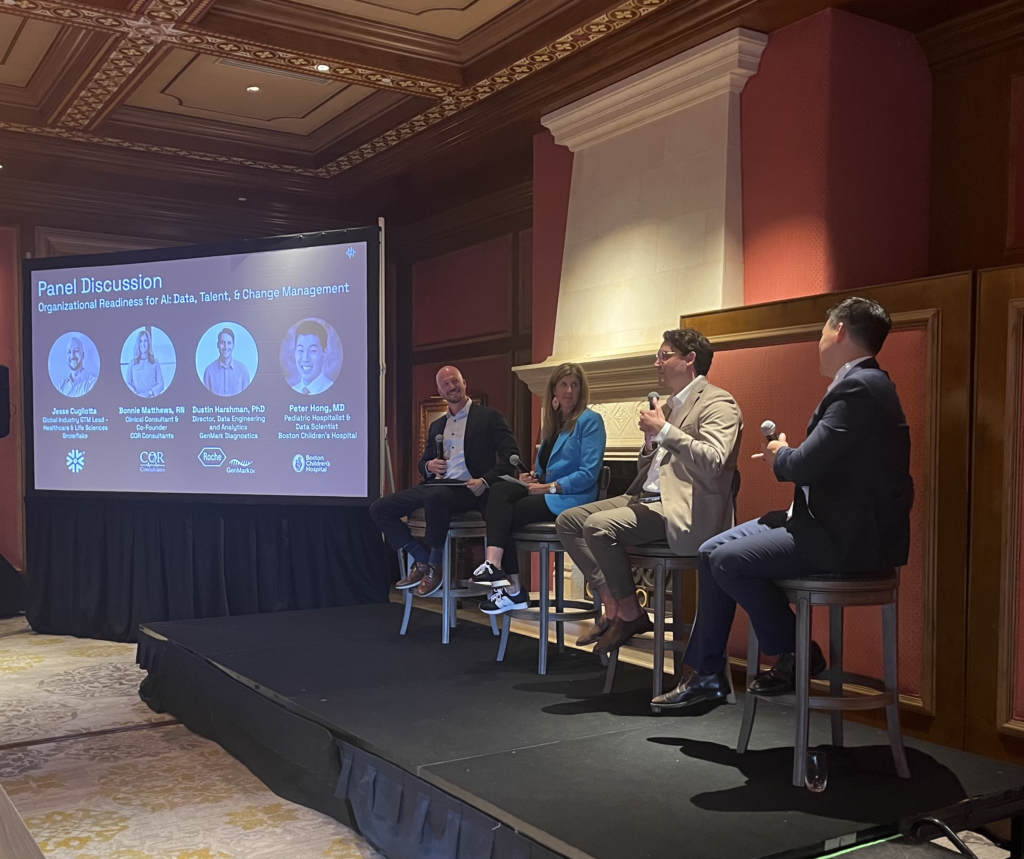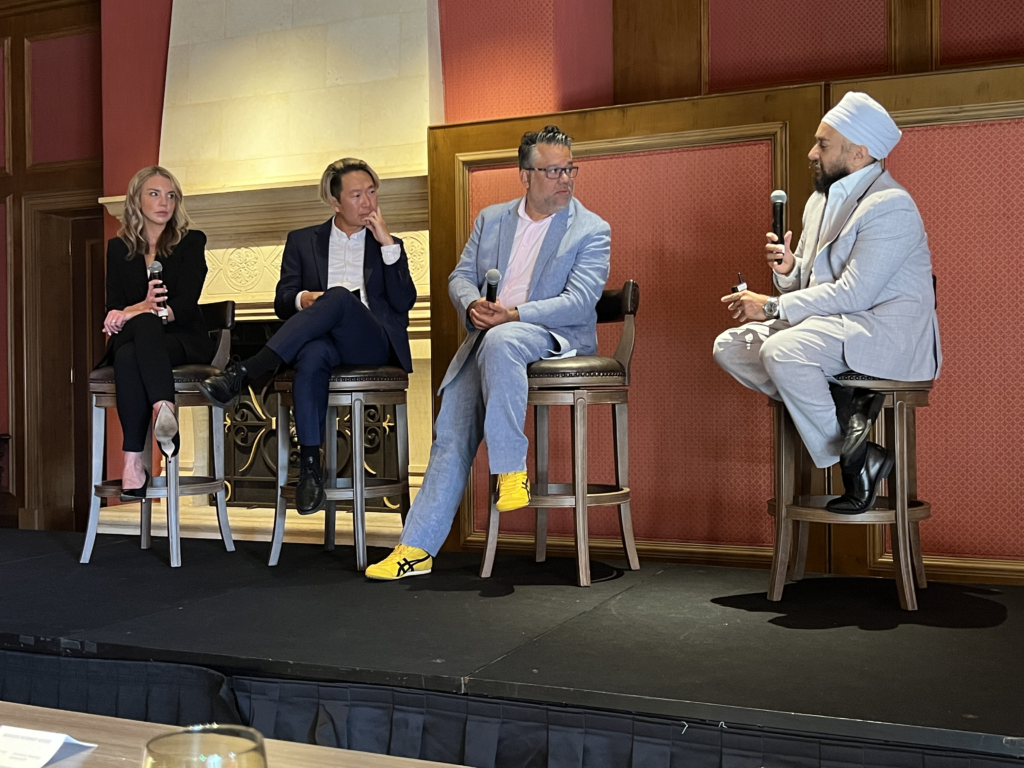In October 2024, Hakkoda held its “AI in Healthcare and Life Sciences Leadership Summit” in San Diego, bringing together thought leaders within the industry to discuss AI’s impact on patient lives. The event’s objective was to discuss use cases for AI that have driven real-world successes in an effort to better understand what AI’s role will be in the next phase of data innovation throughout the healthcare and life sciences (HCLS) world.
Attendees included director to C-level executives from payer, provider, and life science organizations, with panelists ranging from industry experts and executives to data scientists. Discussions focused on what tools and strategies innovators are betting on in 2025, with consideration to financial drivers, the inherent risk of new initiatives, and the current state of the data space for HCLS organizations.
In this article, we’ll take a look at three major takeaways from Hakkoda’s “AI in Healthcare and Life Sciences Leadership Summit,” to better understand what industry leaders expect from AI in 2025.

#1. Improving the Patient Journey with AI is Not Always a Straightforward Path, But Valuable Use Cases Are Emerging
Because AI’s potential is all but limitless, it has taken some time for HCLS innovators to identify its optimal role within their data stacks. The thoughts shared by our Summit panelists reflect the reality that the “shiny new toy” phase of AI is coming to an end, as innovative organizations are increasingly focused on finding practical AI applications that will deliver concrete value, not just in a few years but now.
As one panelist noted, the “front line” for improving patient outcomes is in fact improving provider care, and AI happens to be extremely well-suited to addressing pain points that waste the time and energy of providers. Innovators are therefore leveraging data tools that cut down on scut work to help reduce burnout and underperformance.
Entrusting data sifting to AI and mediating that data through an easy-to-use AI allows healthcare professionals to do the work that only they can do, as human beings. Thus, LMS and LLM technology have proven valuable, lessening the load for providers, who then pass on that value to patients in the form of better healthcare outcomes.
This aligns with the general trend of innovators to first focus on “low hanging fruit,” leveraging AI to address the most basic and high-impact inefficiencies within their organizations.

#2. Bridging Innovation and Implementation Takes an AI Strategy, Leadership, and Buy-In
More specialized AI functions, such as detecting infections at surgical sites for instance, are a heavier lift for a variety of reasons: starting costs, interoperability limitations, facility infrastructure, and so on. Organizations are left to draw their own lines when it comes to balancing their margins and resources against the potential for innovation.
Multiple panelists agreed that the single best tactic for addressing these sort of specialized issues is to have resolute leadership at the very top. A CEO who has a unified vision for their organization’s data goals, as well as the “intestinal fortitude” to see that vision through, can keep HCLS companies from becoming mired down by an excess of suboptimal tools that don’t align with organizational workflow.
Incorporating AI functions into the broader workflow of providers is often inhibited by a lack of buy-in on the ground level, especially from overburdened nursing staff. These functions have little value if they are not put to use, and providers have legitimate concerns about these tools creating even more work for them or even replacing them altogether.
Panelists agreed that AI capabilities should be understood as tools of “assistance” and not “replacement,” given that AI simply cannot replace the work that human providers do. By cutting down on the clerical work that providers find onerous, AI does not create more work for providers but instead refocuses their work on bedside care—i.e., the work that providers actually want to do.
One panelist also proposed introducing AI functions through a “shadow mode” initially, to allow providers to see what benefits these functions could provide without leaving providers feeling as if their agency was being diminished.

#3. Envisioning the Future of AI: How Can HCLS Adapt Faster to the Evolving Data Space?
By far, the single most bemoaned issue was how slow to adapt the HCLS industry has been when it comes to incorporating technologies that other industries have been successfully leveraging for years—or even decades. Despite the unique obstacles that HCLS organizations face with security, privacy, and compliance, panelists were frustrated with the glacial pace at which the industry has adjusted to the modern data landscape.
The lack of interoperability and shareability with EHRs poses an obvious obstacle, as does the corollary issue of Epic and its increasing dominance of the EHR space. One panelist theorized that Epic may become less of an issue in the coming years than many expect, with the organization transitioning into a kind of data repository around which innovation will naturally develop.
Another panelist speculated that a public alternative to Epic is the only path forward when it comes to truly transforming and unifying the EHR landscape. This perspective was challenged when another panelist argued a system could be created where healthcare interactions are automatically reported and recorded, without diminishing the role of private entities like Epic.
Regardless of their predictions, each panelist expressed frustrations over the obstacles that surrounded data sharing and the sluggish adaptation that the HCLS industry has been forced to endure for the past couple decades.

Innovation is Iterative: What Recurring Themes Say About Where AI in Healthcare Goes Next
Hakkoda’s “AI in Healthcare and Life Sciences Leadership Summit” brought together some of the best minds in healthcare and life sciences in the hope of better understanding the role of AI within the industry, both in the present and beyond.
A coherent philosophy emerged from the panel’s discussion: leveraging AI to address basic pain points can assist providers in delivering better patient outcomes. With visionary leadership and buy-in from providers, AI tools streamline workflow, unlock the full potential of healthcare data, and drive value in the form at all levels. The unique challenges of the industry mean that progress can often be slow, but the possibilities for innovation remain as tantalizing as ever.
As Snowflake’s Healthcare and Life Sciences Data Cloud Services Partner of the Year 2024, Hakkoda prides itself on being a part of this urgent conversation and creating a space for thought leaders to speak about AI’s future in HCLS.
If your healthcare or life sciences organization is struggling in its journey toward data innovation, let’s talk today about how Hakkoda can help you build the transformative AI functions that drive value and deliver results.
Want to join the conversation? Click here to learn more about how you can participate in Hakkoda’s next HCLS summit in Lenox, Massachusetts (May 14 – 15, 2025).




